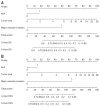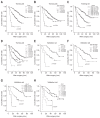Nomograms to Predict the Individual Survival of Patients with Solitary Hepatocellular Carcinoma after Hepatectomy
- PMID: 28651303
- PMCID: PMC5593331
- DOI: 10.5009/gnl16465
Nomograms to Predict the Individual Survival of Patients with Solitary Hepatocellular Carcinoma after Hepatectomy
Abstract
Background/aims: Solitary hepatocellular carcinoma (HCC) is a subgroup of HCCs. We aimed to establish nomograms for predicting the survival of solitary HCC patients after hepatectomy.
Methods: A total of 538 solitary HCC patients were randomly classified into training and validation sets. A Cox model was used to identify predictors of overall survival (OS) in the training set. A nomogram was generated based on these predictors and was validated using the validation set.
Results: Tumor size, microvascular invasion, and major vascular invasion were significantly associated with OS in the training set. Nomograms were developed based on these predictors in the multivariate analysis. The C-index was 0.75 for the OS nomogram and 0.72 for the recurrence-free survival nomogram. Compared to the index of conventional staging systems for predicting survival (0.71 for Barcelona Clinic Liver Cancer, 0.66 for the seventh American Joint Committee on Cancer, 0.68 for Cancer of the Liver Italian Program, and 0.70 for Hong Kong Liver Cancer), the index of the OS nomogram was significantly higher. Moreover, the calibration curve fitted well between the predicted and observed survival rate. Similarly, in the validation set, the nomogram discrimination was superior to those of the four staging systems (p<0.001).
Conclusions: The nomograms demonstrated good discrimination performance in predicting 3- and 5-year survival rates for solitary HCCs after hepatectomy.
Keywords: Carcinoma, hepatocellular; Nomograms; Prognosis; Surgery.
Conflict of interest statement
No potential conflict of interest relevant to this article was reported.
Figures




Similar articles
-
Prognostic nomograms for patients with resectable hepatocelluar carcinoma incorporating systemic inflammation and tumor characteristics.Oncotarget. 2016 Dec 6;7(49):80783-80793. doi: 10.18632/oncotarget.13038. Oncotarget. 2016. PMID: 27811374 Free PMC article.
-
A model prediction of long-term prognosis in patients with centrally located hepatocellular carcinoma undergoing hepatectomy.Eur J Surg Oncol. 2018 Oct;44(10):1595-1602. doi: 10.1016/j.ejso.2018.06.009. Epub 2018 Jun 21. Eur J Surg Oncol. 2018. PMID: 30041973
-
Simplified nomograms based on platelet-associated models for survival prediction in Asian hepatocellular carcinoma patients after surgery.Surg Oncol. 2019 Sep;30:131-138. doi: 10.1016/j.suronc.2019.07.008. Epub 2019 Jul 22. Surg Oncol. 2019. PMID: 31500777
-
Nomogram for preoperative estimation of long-term survival of patients who underwent curative resection with hepatocellular carcinoma beyond Barcelona clinic liver cancer stage A1.Oncotarget. 2016 Sep 20;7(38):61378-61389. doi: 10.18632/oncotarget.11358. Oncotarget. 2016. PMID: 27542216 Free PMC article.
-
Novel Prognostic Nomograms for Hepatocellular Carcinoma Patients with Microvascular Invasion: Experience from a Single Center.Gut Liver. 2019 Nov 15;13(6):669-682. doi: 10.5009/gnl18489. Gut Liver. 2019. PMID: 30970430 Free PMC article.
Cited by
-
Nomograms for prognostic factors of spinal giant cell tumor combining traditional clinical characteristics with inflammatory biomarkers after gross total resection.Oncotarget. 2017 Sep 22;8(49):86934-86946. doi: 10.18632/oncotarget.21168. eCollection 2017 Oct 17. Oncotarget. 2017. PMID: 29156848 Free PMC article.
-
Development and Validation of Pre- and Post-Operative Models to Predict Recurrence After Resection of Solitary Hepatocellular Carcinoma: A Multi-Institutional Study.Cancer Manag Res. 2020 May 15;12:3503-3512. doi: 10.2147/CMAR.S251413. eCollection 2020. Cancer Manag Res. 2020. PMID: 32523380 Free PMC article.
-
Diagnostic value of glypican-3, arginase-1 and hepatocyte paraffin antigen -1 in differentiating hepatocellular carcinoma from intrahepatic cholangiocarcinoma.Transl Cancer Res. 2020 Jan;9(1):128-136. doi: 10.21037/tcr.2019.11.20. Transl Cancer Res. 2020. PMID: 35117166 Free PMC article.
-
Multiple m6A RNA methylation modulators promote the malignant progression of hepatocellular carcinoma and affect its clinical prognosis.BMC Cancer. 2020 Feb 28;20(1):165. doi: 10.1186/s12885-020-6638-5. BMC Cancer. 2020. PMID: 32111180 Free PMC article.
-
Novel Prognostic Nomograms for Predicting Early and Late Recurrence of Hepatocellular Carcinoma After Curative Hepatectomy.Cancer Manag Res. 2020 Mar 9;12:1693-1712. doi: 10.2147/CMAR.S241959. eCollection 2020. Cancer Manag Res. 2020. PMID: 32214844 Free PMC article.
References
Publication types
MeSH terms
LinkOut - more resources
Full Text Sources
Other Literature Sources
Medical

